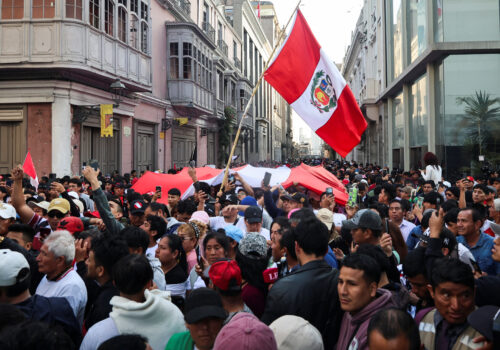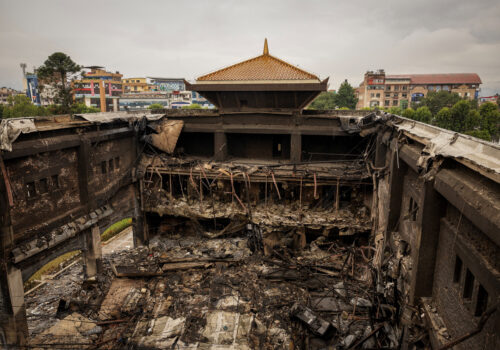The phenomenon of young people driving consequential political change is not new.
During the Arab Spring in 2011 and 2012, many large-scale demonstrations were led or at least widely participated in by youth. More recently, young voters helped unseat the party that had governed Botswana since independence and caused the vote share of South Africa’s African National Congress party to fall below 50 percent for the first time since the end of apartheid. Youth protesters in Bangladesh, too, ousted the government of former Prime Minister Sheikh Hasina in July 2024.
Even against this backdrop, however, the global scale and impact of the Gen Z protests in the past year is unprecedented.
In Kenya, protests against rising prices, youth unemployment, and corruption broke out after the announcement of new tax hikes in 2024, with further protests taking place in July. In Indonesia, young people have been protesting against high allowances for members of parliament and widespread food poisoning brought about through the government’s school meals program. In the Philippines, public demonstrations sparked by the misallocation of flood relief funds began in September.
And there’s more. Outraged by government bans on social media, young people in Nepal burned the parliament building and ousted the sitting government on September 9. The same month, Peruvian youth protesting against increased crime and corruption sparked conversations about government overhaul. Morocco’s “Gen Z 212” movement, (named after the country’s international dialing code), took to the streets to express their frustration with government funds being directed toward preparations for the 2030 World Cup rather than public services. Just last month, demonstrations by disillusioned youth in Madagascar sparked by water and electricity failures sent the president into exile and prompted a military-led government overhaul.
The root causes of public upheaval vary widely across these seven countries, as do the countries’ political contexts and the ultimate outcomes of their youth-led protest movements. Moreover, these seven countries are by no means the only nations around the world that have experienced mass protests led by young people dissatisfied with the political status quo in the past few years, as evidenced by youth-led protest movements in Serbia and South Korea.
Even so, the past year’s Gen Z protests are worth analyzing together for what they have in common, as these movements are influenced by one another and were all initiated by youth adept at using technology to organize. And, as the Freedom and Prosperity Indexes demonstrate, there are other broad similarities that warrant further examination.
What do the data tell us?
For starters, six of the seven countries score well above their respective regional averages in the political rights component of the Freedom Index, indicating that these countries protect freedom of association, expression, and access to information better than their neighbors. The only exception is Peru, which only recently saw its political rights score dip below the Latin America and the Caribbean regional average.
Secondly, these countries all perform below the regional average on at least one key metric of prosperity, whether that be income, health, or education.
Nepal and Madagascar score higher than their regional averages on political rights
Nepal and Madagascar score lower than their regional averages on income
If people are prone to comparing their conditions to those of their counterparts in neighboring countries, then the data indicate that conditions for protests may be largely defined by an appreciation for relatively high levels of political expression and a frustration with relative shortfalls in income levels, health standards, or education quality.
Lastly, and critically, these countries all have notably high youth populations. In all seven countries, the median age is lower than the global median and the percentage of the total population between the ages of fifteen and twenty-four is higher than the global average.
What the data show, then, is that all these countries have a lot of young people with an understanding of democratic rights, expectations of government accountability, and legitimate grievances related to the lack of government service provision.
Pair that with a growing confidence in their ability to drive change due to youth protests that came before and access to technology that allows them to easily communicate and organize, and you get the globally connected youth movement that has sprung up in recent months.
A force for positive change, or a temporary disruption of the status quo?
Attempting to find explanations for why these youth-led protests are happening is important, but assessing their impact is even more critical. Of the seven countries where protests have occurred or, in the cases of Morocco and Peru, are still occurring, two have experienced full regime change.
In both Nepal and Madagascar, the head of state was removed and replaced with interim governments organized by military figures. Perhaps one explanation for the protests leading to regime change in these two countries is that, in both cases, the military stood by and allowed protests to oust the sitting government before ushering in transitional governments of their liking. In both countries, the political influence of the young people who instigated the upheaval has diminished as new governing regimes have taken shape. Youth in Madagascar have expressed frustration with a career politician and former opposition leader being chosen to lead the country’s National Assembly, and Nepalese protest leaders say they have been frozen out of the transitional government.
The effects of the Gen Z protests in countries that have not experienced regime or leadership change have been mixed. In Kenya, protesters succeeded in convincing President William Ruto to withdraw his contentious tax bill but failed to bring about the systemic change that many wanted. The Moroccan government has responded to protests by pledging to increase health and education spending, but protesters remain unsatisfied.
If the aftermath of the Arab Spring and last year’s revolution in Bangladesh are any indication, establishing more accountable democracies through youth mobilization will prove exceptionally challenging. It is too early to tell whether the recent youth protests will truly bring about the systemic change that young people are demanding, but breaking with history will undoubtedly require young people to sustain the tremendous organized effort they have undertaken.
What’s next?
As the effects of Gen Z protests continue to materialize, there are two important questions to consider.
First, can young people use their numbers and organizational power to make government more democratic, more accountable, and less corrupt in the long term?
Only time will tell whether the answer to this question is yes or no.
The second question is perhaps more interesting: Based on the characteristics of the countries where Gen Z protests have occurred, is it possible to predict where they will happen next?
While exact predictions are impossible, the number of countries with characteristics like those of the seven examined above is limited. For example, Honduras has a high youth population, scores well above the regional average on political rights, and scores well below regional income and education averages. Côte d’Ivoire also has a high youth population, scores well above the average Sub-Saharan African country on political rights, and scores below the regional average on health and inequality. If the governments of either of these countries are widely blamed for corruption or failure to deliver services among younger people, youth populations may well follow the example their counterparts around the world have set. In Côte d’Ivoire, initial frustration over the results of last month’s presidential election could serve as a flashpoint for prolonged unrest.
Côte d’Ivoire scores higher than the regional average on political rights
Côte d’Ivoire scores lower than the regional average on life expectancy
Broadly, the data show that countries within the “low freedom” and “low prosperity” categories that have high youth populations and relatively well-protected political rights, and that perform relatively poorly in at least one indicator of prosperity, appear more prone to Gen Z demonstrations.
This is not to say that Honduras, Côte d’Ivoire, or other countries that share similar characteristics are destined for a youth uprising. But it certainly should not come as a surprise if the movement of youth-led protests spreads further across the developing world.
Protesters in Madagascar took inspiration from the Gen Z movement in Nepal, which was in turn inspired by demonstrations in Indonesia. With protests in Peru and Morocco continuing, it is possible that the wave of Gen Z frustration with a lack of government effectiveness and accountability is only just getting started.
What is certain is that increased access to technology and global information has empowered youth in limited, flawed, and unaccountable democracies to attempt to incite change through organized protest.
The voices of these young people are undoubtedly being heard; whether their demands will be met remains to be seen.
Will Mortenson is a program assistant at the Atlantic Council’s Freedom and Prosperity Center.
Further reading
Mon, Oct 27, 2025
Peru at a breaking point: How ten years of political chaos opened the door to organized crime
New Atlanticist By Martin Cassinelli
Unless the next government restores both security and institutional credibility, Peru’s democracy risks becoming not merely ungovernable, but unrecognizable.
Fri, Sep 19, 2025
The economic roots of Nepal’s uprising—and what it means for the region
New Atlanticist By
The pattern of regime collapses in Nepal, Bangladesh, and Sri Lanka over the past few years suggests a region-wide crisis of governance linked to economic despair.
Thu, Oct 2, 2025
Four questions (and expert answers) about the antigovernment protests in Morocco
New Atlanticist By Sarah Zaaimi
Mass protests over economic conditions led by members of Morocco’s Gen Z continued to escalate in multiple cities on Thursday.
Image: Members of Generation Z (GENZ212) hold signs and chant slogans for dignity freedom and social justice in front of Parliament in Rabat in Morocco on October 18 2025. Issam Zerrok / Hans Lucas via Reuters Connect.




